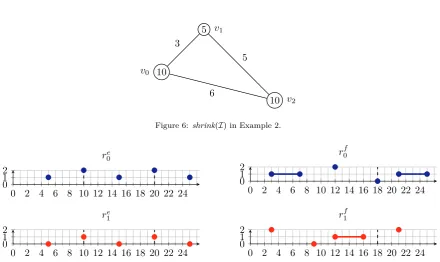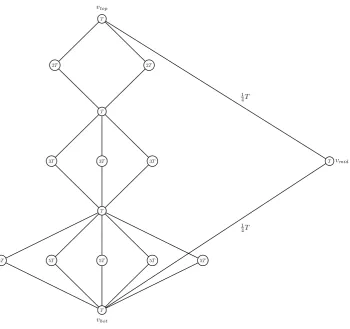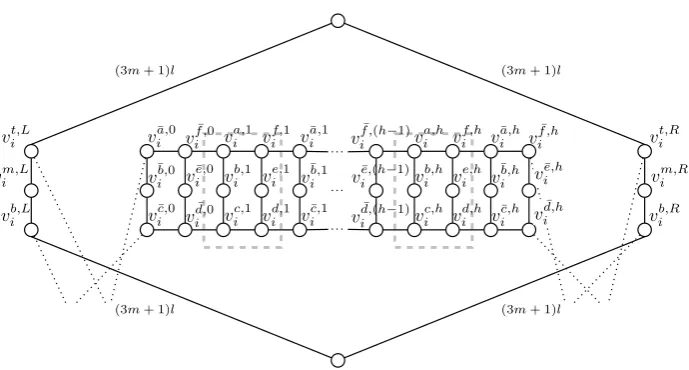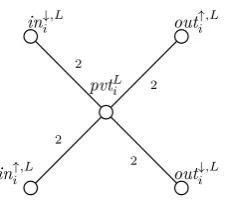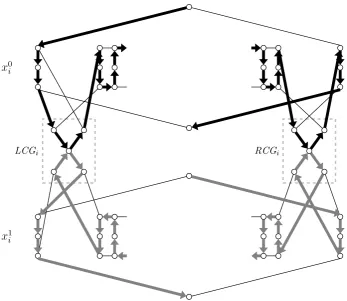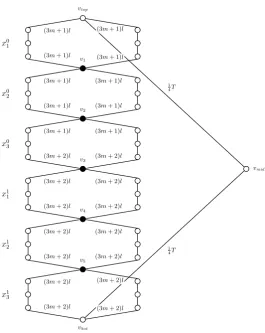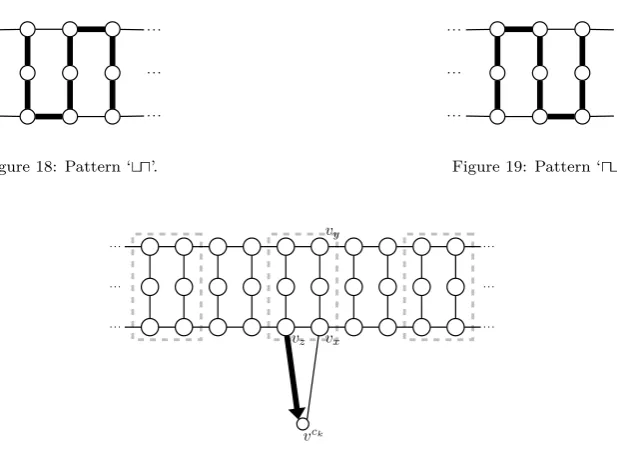Cyclic-routing of Unmanned Aerial Vehicles
DRUCKER, N, HO, H M <http://orcid.org/0000-0003-0387-4857>,
OUAKNINE, J, PENN, M and STRICHMAN, O
Available from Sheffield Hallam University Research Archive (SHURA) at:
http://shura.shu.ac.uk/25240/
This document is the author deposited version. You are advised to consult the
publisher's version if you wish to cite from it.
Published version
DRUCKER, N, HO, H M, OUAKNINE, J, PENN, M and STRICHMAN, O (2019).
Cyclic-routing of Unmanned Aerial Vehicles. Journal of Computer and System
Sciences, 103, 18-45.
Copyright and re-use policy
See http://shura.shu.ac.uk/information.html
Cyclic-Routing of Unmanned Aerial Vehicles
INir Druckera, Hsi-Ming Hob, Joël Ouakninec,b, Michal Penna, Ofer Strichmana
aIndustrial Engineering and Management, Technion, Haifa, Israel bDepartment of Computer Science, University of Oxford, Oxford, UK cMax Planck Institute for Software Systems, Saarland Informatics Campus, Germany
Abstract
Various missions carried out by Unmanned Aerial Vehicles (UAVs) are concerned with permanent monitoring of a predefined set of ground targets underrelative deadlineconstraints, i.e., the targets have to be revisited ‘indefinitely’ and there is an upper bound on the time between two consecutive successful scans of each target. Asolution to the problem is a set of routes—one for each UAV—that jointly satisfy these constraints. Our goal is to find a solution with the least number of UAVs. We show that the decision version of the problem (given k, is there a solution with k UAVs?) is PSPACE-complete. On the practical side, we propose a portfolio approach that combines the strengths of constraint solving and model checking. We present an empirical evaluation of the different solution methods on several hundred randomly generated instances.
Keywords:
motion planning, computational complexity, model checking
1. Introduction
Unmanned Aerial Vehicles (UAVs) have many uses, ranging from civilian to military operations. Like other autonomous systems, they are particularly well-suited to ‘dull, dirty and/or dangerous’ missions [2]. A common scenario in such missions is that a set of targets have to be visited (or, more aptly, scanned) by a limited number of UAVs. This has given rise to a large body of research onroute planningfor UAVs. Depending on the specific application at hand, routes of UAVs may be subject to various complex constraints, e.g., related to kinematics or fuel (see, among others, [3, 4, 5, 6]). In this work, we focus primarily on timing constraints and consider theCyclic-Routing UAV problem (cr-uav) [7]: a recurrent UAV route-planning problem in which each target must be scanned not only once but repeatedly, i.e., at intervals of prescribed maximal duration (relative deadline). With the minimal flight time between each (ordered) pair of the targets and the minimal scanning time needed for each target also given as inputs, a solution is a set of (infinite) routes that together satisfy these timing constraints. The goal is to find a solution with the least possible number of UAVs. As an example, consider a number of sensitive areas that have to be monitored permanently to prevent intrusion. An obvious solution is to simply deploy one UAV to stay at each location. To save costs, however, one seeks to minimise the number of UAVs used while ensuring that the time between any two consecutive successful scans of each target, plus the reaction time of security forces, is not longer than the time it takes for a successful intrusion. Similar applications include inspection of bridges and dams for damage, surveillance of oil and gas pipelines for spillage, monitoring of forests for fire, etc.
IPart of this work appeared in theProceedings of the 18th International Conference on Foundations of Software Science
and Computation Structures(2015), and in theProceedings of the 13th International Conference on Integration of Artificial Intelligence and Operations Research Techniques in Constraint Programming(2016). Joël Ouaknine was supported by ERC grant AVS-ISS (648701), and by the Deutsche Forschungsgemeinschaft (DFG, German Research Foundation) — Projektnummer 389792660 — TRR 248.
Email addresses: nirdru@gmail.com(Nir Drucker),hsimho@gmail.com(Hsi-Ming Ho),joel@mpi-sws.org
We give a formal definition of the cr-uavproblem in Section 2. While the problem is formulated in a very general manner, we make some useful observations to simplify the analysis and modelling in later sections. In particular, we can focus on solutions that are periodic and integer-timed. The complexity of thecr-uavproblem is studied in Section 3. We first show that the period of a solution can be exponential in the size of the inputs, refuting an incorrect claim in the literature [8]. Then, extending this idea, we show that the problem is indeed PSPACE-hard by reducing from theperiodic satproblem, known to be PSPACE-complete [9]. We derive lower and upper bounds on the numberkof required UAVs in Section 4 and detail a reduction from the decision version of thecr-uavproblem to the model-checking problem for Linear Temporal Logic (LTL) [10] on symbolic transition systems in Section 5. Thecr-uavproblem can then be solved by a binary search onk, invoking a model checker in each step. In Section 6, we propose a simple approach to thecr-uav problem: use a satisfiability-modulo-theories (SMT) solver [11] to find solutions and run, in parallel, a dedicated algorithm to prove that no solution exists. We also exhibit a method to reduce the searched state-space, which simplifies both tasks, based on asimulation relation. Experimental results are reported in Section 7 where we compare the efficiency of the approaches proposed in Sections 5 and 6. We close the article with some discussion and outlook in Section 8.
This paper is a revised and extended version of two conference papers [12, 13]. This new version contains a more precise formulation of the problem, a reduction to model checking, and new experimental results.
2. Definitions
2.1. Scenario and problem inputs
Let there be a number of targets, i.e., areas to be scanned, and a flock of UAVs, which we treat as free-moving points. Each target is associated with ascanning time: the least amount of time a UAV must stay at the target to complete a successful scan. Moreover, each target has arelative deadline: an upper bound requirement on the time between two consecutive successful scans. We make several assumptions:
• When more than one UAV are involved, each UAV flies at a different altitude. This allows us to ignore the issue of intersecting routes that might otherwise lead to collisions.
• All UAVs are identical, i.e., their top speeds are the same. It follows that we can associate with each ordered pair of targets a flight time: the least amount of time needed for a UAV to fly from some point within the first target to somepoint within the other.
• Scans of targets are not split between UAVs.
• The scanning time of each target is not less than the least amount of time needed for a UAV to fly betweenany two points within the target. Thus, we can ignore the actual shape of each target and imagine it as a circle with scanning time as the ‘diameter’.
In the rest of this article we fix the set of n targets to be V ={0, . . . , n−1} and let vi = i, v1 = 1, …, vn−1=n−1. In this way, we can refer to the elements ofV not only as targets, but also as unique indices.
The inputs are as follows:
1. An arraySTof sizensuch that for everyv∈V,ST[v]is the scanning time ofv. 2. An arrayRDof sizensuch that for every v∈V,RD[v]is the relative deadline ofv.
3. A two-dimensional arrayFTof sizen×nsuch that for every pairv, v′∈V,FT[v, v′]is the flight time fromv tov′. In particular,FT[v, v′] = 0if and only ifv=v′.
Time units are chosen so that all the scanning times, relative deadlines and flight times are non-negative integers. We further assume thatFT[v, v′] +ST[v′] +FT[v′, v′′]≥FT[v, v′′]for allv, v′, v′′∈V—as we will show later on, we can transform the input problem into an equivalent one without scanning times, from which it then follows that we are working with a metric. Without loss of generality, we further require that (i)ST[v] is even for allv ∈V (as we will divideST[v] by2 in the said transformation), (ii)RD[v]>0 for allv∈V.1
1IfRD[v] = 0one may simply assign to each suchva dedicated UAV; it can be shown that this strategy does not affect the
2.2. Routes and solutions
Now letI =⟨ST,RD,FT⟩be an instanceof the problem. Aroute ofI is a function rfrom R>0 (the
positive reals) toVϵ=V ∪ {ϵ}such that:
• For allt, t′∈R>0, t < t′ and v, v′∈V such thatr(t) =v andr(t′) =v′, we havet′−t≥FT[v, v′].
Intuitively, a route records the trajectory of a UAV, which may be at some target or ‘in transit’ (represented by the special symbolϵ) at any given time. For a positive integerP, we denote byr↾(0,P] the restriction of
rto the right-closed interval (0, P]. If r= (r↾(0,P])ω, i.e., r is the infinite concatenation ofr↾
(0,P], we say
that r isperiodic, P is a period of r, and r↾(0,P] is a cycleof r. To capture successful scans, we define a functionsecuredr from R>0 to Vϵ for each router: securedr(t) =v if (i)ST[v] = 0 and r(t) =v or (ii)
ST[v]>0 andr(t′) =v for allt′ ∈(t−ST[v], t); otherwisesecuredr(t) =ϵ. Intuitively,securedr(t) =v for v ∈V only when the UAV stays ‘long enough’ at v. Asolution to I with k UAVs (k ≥1) is an indexed setS ofkroutes that satisfies the following conditions:
• For allv∈V, we havesecuredr(t) =vfor some r∈S andt∈(0,RD[v]].
• For all v ∈ V, t, t′ ∈ R>0 with t′−t = RD[v], we have (i) securedr(t′′) = v for some r ∈ S and t′′∈(t, t′), or (ii)securedr(t) =v for somer∈S andsecuredr′(t′) =v for somer′∈S.
The first condition requires that the first successful scan of each target v to be done, at the very latest, by its relative deadlineRD[v].2 The second condition ensures that in any time interval of lengthRD[v], a
successful scan must happen within the inteval or at its endpoints. We sayS={r0, . . . , rk−1} has a period P ifri = (ri↾(0,P])ω for alli∈ {0, . . . , k−1}; in this case, S′={r0↾(0,P], . . . , rk−1↾(0,P]} is a cycle ofS. In
particular, if eachri (i∈ {0, . . . , k−1}) has a periodPi, then the least common multiple ofP1, …, Pk−1 is
a period ofS={r0, . . . , rk−1}.
Example 1. ConsiderI=⟨ST,RD,FT⟩where
ST=[0 4 0] RD=[10 5 10] FT=
01 10 63
6 3 0
,
as illustrated in Fig. 1. Two solutionsSa (with a period10) andSb (with a period18) toI are depicted in
Figs. 2 and 3 where the horizontal axes are timet, the vertical axes are the indices of the targets, and the multiples of the periodP are indicated with dashed lines. The set of routes Sc={rc
0, r1c}(in Fig. 4) is not
a solution toI since the relative deadlines ofv0 andv2 are clearly violated. The functionrd
1 (in Fig. 5) is
not a route ofI sincerd
1(4) =v0,rd1(8) =v2, but8−4<FT[v0, v2] = 6.
2.3. Objective
We now formally define thecr-uavproblem and the associated decision problem.3
Definition 1(Thecr-uavproblem). GivenI =⟨ST,RD,FT⟩as described above, output a solution with the least possible number of UAVs.
Definition 2 (The decision version of the cr-uavproblem). Given I =⟨ST,RD,FT⟩ as described above and a positive integerk, is there a solution with kUAVs?
2Note in passing that we postulate that all UAVs use a global clock which starts at time0.
5
10
10
ST[v1] = 4
ST[v0] = 0
ST[v2] = 0
v1
v0
v2 1
[image:5.595.219.377.113.232.2]6 3
Figure 1: I in Example 1. The flight times are labelled on the edges (FTis symmetric in this example) and the relative deadlines are labelled on the targets; the scanning times are labelled adjacent to the targets.
v1
v0
v2
0 2 4 6 8 10 12 14 16 18 20 22 24
0 1 2
ra 0
0 2 4 6 8 10 12 14 16 18 20 22 24
0 1 2
[image:5.595.306.519.286.480.2]ra 1
Figure 2: Ak= 2solutionSa={ra
0, ra1}toIin Example 1.
v1
v0
v2
0 2 4 6 8 10 12 14 16 18 20 22 24
0 1 2
rb 0
0 2 4 6 8 10 12 14 16 18 20 22 24
0 1 2
[image:5.595.82.282.301.480.2]rb 1
Figure 3: Ak= 2solutionSb={rb
0, rb1}toI in Example 1.
2.4. Related work
As we will see in Section 3, (the decision version of) the cr-uav problem is PSPACE-complete, and hence NP-complete problems cannot be more than weakly related to this problem. We nevertheless briefly mention here two problems that have interesting connections tocr-uav.
The first of those is the generalised windows scheduling problem [14]. The input to this problem is a sequence of n pairs of positive integers ⟨(w1, l1),(w2, l2), . . . ,(wn, ln)⟩. Each such pair corresponds to a
job that has to be scheduled, such that the processing length of job i isli slots and the window between
two consecutive beginnings of executions of jobi is at most wi slots. The goal is to repeatedly and
non-preemptively schedule all the jobs on the fewest possible machines under these constraints. This problem is a special case of cr-uav, where flight times between targets are uniform. In that case we can simply add the flight time to the scanning time at the target and consider the move between targets as instantaneous (i.e., no flight time). Now the scanning time at targetiisliand the relative deadline iswi, which is exactly the generalised windows scheduling problem. Interestingly, [14] mentions that this problem is known to be NP-hard, but neither there or anywhere else did we find a result showing the exact complexity class of this problem.
0 2 4 6 8 10 12 14 16 18 20 22 24 0
1 2
rc0
0 2 4 6 8 10 12 14 16 18 20 22 24
0 1 2
[image:6.595.82.521.110.227.2]rc 1
Figure 4: Sc={rc0, r1}c is not a solution toIin Example 1 as
v0andv2 miss their relative deadlines.
0 2 4 6 8 10 12 14 16 18 20 22 24
0 1 2
rd 0
0 2 4 6 8 10 12 14 16 18 20 22 24
0 1 2
rd 1
Figure 5: r1dis not a route of I in Example 1 asrd1(4) =v0,
rd
1(8) =v2butFT[v0, v2] = 6.
processors periodically, with exact relative deadlines, in contrast tocr-uavwhere the relative deadlines are only upper bounds (i.e., we can visit the target earlier and reset the clock). Also, the flight time incr-uav
cannot simply be reduced to be the processing time in [15] because the processing time only depends on the current task whereas incr-uavthe flight time depends on both the current and the next task.
Additional related work is mentioned in Section 8.
2.5. Some simplifying observations
We now describe some observations regarding inputs and solutions to the problem. As we will soon see, these observations greatly simplify the analysis and modelling in later sections.
Eliminating scanning times. Recall that each targetv is anarea, and we therefore treat it as a circle with ‘diameter’ST[v]. This complication, however, can be avoided by ‘shrinking’ each target to a point. Formally, forI =⟨ST,RD,FT⟩, defineshrink(I) =⟨ST′,RD,FT′⟩whereST′[v] = 0,FT′[v, v] = 0 for allv∈V, and FT′[v, v′] = 12ST[v] +FT[v, v′] +12ST[v′]for all distinctv, v′ ∈V.
Proposition 1. For any I and k ≥1, I has a solution with k UAVs iff shrink(I) has a solution with k
UAVs.
Proof. Consider a solutionS to I =⟨ST,RD,FT⟩. We define, for each r∈S, a corresponding function r′:
r′(t) =v (v∈V) ifsecuredr(t+12ST[v]) =v andr′(t) =ϵotherwise. Ifr′(t) =v,r′(t′) =v′ for somet, t′∈
R>0,t < t′and distinctv, v′∈V, we havesecuredr(t+12ST[v]) =vandsecuredr(t′+12ST[v′]) =v′, which in
turn giver(t′′) =v for allt′′∈(t−21ST[v], t+12ST[v])andr(t′′′) =v′ for allt′′′∈(t′−12ST[v′], t′+12ST[v′])
(assumingST[v],ST[v′]>0). Now sincet′′′−t′′can be arbitrarily close tot′−12ST[v′]−(t+12ST[v]), yet for any sucht′′andt′′′ it must be the case thatt′′′−t′′≥FT[v, v′], we havet′−t≥12ST[v] +FT[v, v′] +12ST[v′]. It follows thatr′ is a route ofshrink(I), and one can show that{ri′ | ri ∈S, 0 ≤i <|S|}is a solution to shrink(I)with a simple proof by contradiction. Conversely, given a solution S′ to shrink(I), we define a functionfr′ from R>0to Vϵ for eachr′∈S′: fr′(t) =v ifr′(t−12ST[v]) =v andfr′(t) =ϵotherwise. Now
definer′′(t) =v (v ∈V) if (i)ST[v] = 0and fr′(t) =v, or (ii)ST[v]>0and there exists t′> t such that
fr′(t′) = v and t′−t < ST[v], and r′′(t) = ϵ otherwise. Finally let r(t) = r′′(t+12maxv∈V{ST[v]}) (the
purpose of the extra shifting is to ensure that the first successful scans to the targets are completed in time). Similarly, one can verify thatris a route ofI and{ri|ri′∈S′, 0≤i <|S′|}is a solution toI.
Example 2. ConsiderI in Example 1. We haveshrink(I) =⟨ST′,RD,FT′⟩where
ST=[0 0 0] RD=[10 5 10] FT=
03 30 65
6 5 0
,
as illustrated in Fig. 6. Two solutions toshrink(I),Se(corresponding toSa in Fig. 2) andSf(corresponding
5
10
10 v1
v0
v2 3
[image:7.595.79.520.88.350.2]6 5
Figure 6:shrink(I)in Example 2.
0 2 4 6 8 10 12 14 16 18 20 22 24
0 1 2
re 0
0 2 4 6 8 10 12 14 16 18 20 22 24
0 1 2
re 1
Figure 7: A solutionSe={re
0, r1e}toshrink(I)in Example 2.
0 2 4 6 8 10 12 14 16 18 20 22 24
0 1 2
r0f
0 2 4 6 8 10 12 14 16 18 20 22 24
0 1 2
r1f
Figure 8: A solutionSf ={rf 0, r
f
1}toshrink(I)in Example 2.
Thanks to Proposition 1 we can (without loss of generality) disregard ST altogether and from now on consider onlyI =⟨RD,FT⟩whereFT[v, v′] +FT[v′, v′′]≥FT[v, v′′]for all distinctv,v′,v′′. In the sequel, we call such anI aninstanceof thecr-uavproblem.
Digitisation of solutions. We say a router is integer-timediff the UAVs only reach/leave the targets at integer time points (i.e., for each non-negative integer N, either (i)r(t′) = v for all t′ ∈ (N, N + 1) and somev∈V, or (ii) r(t′) =ϵfor allt′∈(N, N + 1)). We say a routerisinstantaneousiff the UAV never stays at a target inr(i.e.,r(t)≠ ϵimplies thattis a point of discontinuity ofr).4 These notions extend to
solutions in the expected way. The following proposition is reminiscent of a standard digitisation result in the theory of timed automata [16].
Proposition 2. For anyIandk≥1, a solution toI withkUAVs can be transformed into an instantaneous integer-timed solution to I with kUAVs.
Proof. Consider a solution S to I = ⟨RD,FT⟩. We define, for each r ∈ S, a corresponding function rd: rd(t) =v(v∈V) iftis a positive integer and (i) there existst′≥tsuch thatt′−t < 1
2 andr(t′) =v, or (ii)
there existst′′≤t such thatt−t′′≤ 1
2 andr(t′′) =v, and r
d(t) =ϵotherwise (note thatrd is well-defined
as we haveFT[v, v′] ≥1 for all distinct v, v′ ∈V). Obviously, all the routes in {rd
i | ri ∈S, 0 ≤i <|S|}
are instantaneous and integer-timed. Now suppose to the contrary that {rd
i |ri ∈ S, 0 ≤ i <|S|} is not
a solution to I; in other words, there are t, t′ ∈R>0 such that (i)t′−t=RD[v]≥1 for some v∈ V, (ii) rd
i(t′′)̸=v for alli, 0≤i <|S|andt′′∈(t, t′), and (iii) ifrdi(t) =v for somei,0≤i <|S|thenrid(t′)̸=v
for alli,0≤i <|S|, and vice versa. Consider the following cases:
• Both tand t′ are integers: ifrd
i(t)̸=v and rdi(t′)̸=v for all i,0 ≤i <|S|then obviouslyri(t′′)̸=v
for all i, 0≤i <|S| and t′′ ∈[t, t′]. If, say, rid(t) =v, we must have ri(t′′)≠ v for alli, 0 ≤i <|S|
andt′′∈[t+12, t′+12). In both subcases,S cannot be a solution toI, which is a contradiction.
• Bothtandt′ are not integers: asrd
i(⌈t⌉)̸=vandrdi(⌊t′⌋)≠ v for alli,0≤i <|S|, we haveri(t′′)̸=v
for alli, 0≤i <|S|and t′′∈[⌈t⌉ −12,⌊t′⌋+12). Sincet′−t=⌊t′⌋ − ⌈t⌉+ 1, S cannot be a solution toI, which is a contradiction.
Example 3. ConsiderJ =⟨RD,FT⟩where
RD=[3 3 3 3] FT=
0 2 3 2
2 0 2 3
3 2 0 2
2 3 2 0
,
as illustrated in Fig. 9. A solutionSg(in which the UAVs reach/leave the targets at non-integer points) and
its ‘digitised’ counterpartSh(in which the UAVs reach/leave the targets only at integer points) are depicted
in Figs. 10 and 11, respectively.
[image:8.595.72.523.317.614.2]3 3 3 3 v1 v0 v2 v3 2 2 2 3 3 2
Figure 9: J in Example 3.
0 1 2 3 4 5 6 7 8 9 10
0 1 2 3
rg0
0 1 2 3 4 5 6 7 8 9 10
0 1 2 3
r1g
0 1 2 3 4 5 6 7 8 9 10
0 1 2 3
r2g
Figure 10: A solutionSg={rg 0, r
g 1, r
g
2}toJ in Example 3.
0 1 2 3 4 5 6 7 8 9 10
0 1 2 3 rh 0
0 1 2 3 4 5 6 7 8 9 10
0 1 2 3
r1h
0 1 2 3 4 5 6 7 8 9 10
0 1 2 3 rh 2
Figure 11: An integer-timed solution Sh={rh
0, r1h, r2h}toJ
in Example 3.
In light of Proposition 2, from now on we letFT[v, v] = 1(instead of0) for all v∈V.
Punctuality of solutions. We say a routerispunctual iff for allt, t′ ∈R>0,t < t′, andv, v′∈V such that r(t) =v,r(t′) =v′, andr(t′′) =ϵfor allt′′∈(t, t′), either (i)v̸=v′ andt′−t=FT[v, v′], or (ii)v=v′ and
t′−t= 1. We now show that it suffices to consider punctual solutions (i.e., all routes are punctual).
[image:8.595.315.519.414.596.2]Proof. Consider an instantaneous integer-timed solutionS to I = ⟨RD,FT⟩. For each r ∈S, let r′ be a route such that
• r′(t′′) = v′ (v′ ∈V) if t′′ is a positive integer and either (i) r(t′′) = v′, or (ii) t′′ ∈(t, t′), r(t) = v,
r(t′) = v′, r(t′′′) = ϵ for all t′′′ ∈ (t, t′), and t′′−t ≥FT[v, v′] for some positive integers t, t′ and
v∈V;
• r′(t′′) =ϵotherwise.
Intuitively, arriving earlier at targets and staying (whenever possible) cannot invalidate a solution. Thus, it is clear that{ri′|ri∈S, 0≤i <|S|}is a punctual instantaneous integer-timed solution toI.
Periodicity of solutions. Our final observation, stated in the proposition below, enables us to consider only periodic solutions without sacrificing correctness.
Proposition 4. For any I and k≥1, a punctual instantaneous integer-timed solution toI with k UAVs can be transformed into a periodic punctual instantaneous integer-timed solution toI with k UAVs.
Proof. GivenI andk≥1, letprefixI,k be the set ofk-tuples⟨f0, . . . , fk−1⟩where there is a positive integer T such that
• eachfi is of the formr↾(0,T] where ris a punctual instantaneous integer-timed route ofI,
• ri(T) =v for somei∈ {0, . . . , k−1}andv∈V, and
• for eachv∈V,ri(T′) =v for someT′≤T andi∈ {0, . . . , k−1}.
Now define an equivalence relation ∼ on prefixI,k: ⟨f0, . . . , fk−1⟩ ∼ ⟨g0, . . . , gk−1⟩ iff for each k-tuple ⟨r0, . . . , rk−1⟩ of punctual instantaneous integer-timed routes of I, {f0r0, . . . , fk−1rk−1} is a solution to I whenever{g0r0, . . . , gk−1rk−1} is a solution toI. We will see in Section 5 that ∼partitionsprefixI,k into
finitely many equivalence classes. Therefore, ifS is a punctual instantaneous integer-timed solution to I
with k UAVs, there must be two distinct ‘prefixes’ ofS that are∼-equivalent. The proposition follows by repeating the in-between partad infinitum.
Corollary 1. For anyI andk≥1, a solution toIwithkUAVs can be transformed into a periodic punctual instantaneous integer-timed solution toI withk UAVs.
Following Corollary 1, we will only consider periodic punctual instantaneous integer-timed solutions in the rest of this article.
3. Complexity
We will see in Section 5 that the decision version of the cr-uav problem can be solved in PSPACE via a rather straightforward reduction to LTLmodel-checking on symbolic transition systems [17]. On the other hand, it is not immediate whether the problem can be solved in NP. It is claimed in [8] that in the single-UAV case (i.e., k= 1), it suffices to consider solutions with periods bounded by the largest relative deadline; if constants are encoded in unary, this would immediately imply NP-membership of the problem in the single-UAV case. However, that claim is unfortunately wrong, because of the following proposition.
Proposition 5. There is a family of cr-uavinstances{In}n>0 such that the shortest possible period of a
single-UAV solution toIn is exponential in the size ofIn.5
Proof. (Sketch.) See Fig. 12 for an illustration ofI3. The i-th ‘diamond’ (i≥ 1, in top-down order) has pn branches where pn is then-th prime number. Each unlabelled edge has flight time set to 1, and each
missing edge has flight time set to the ‘shortest distance’ between the two relevant targets. It can be shown that a solution must be an infinite repetition of either (i) fromvtopthrough all the diamonds tovbot, tovmid and tovtopagain, or (ii) fromvbotthrough all the diamonds tovtop, tovmidand tovbotagain; without loss of generality we assume (i). In this case, in each diamond one must go straight down, and only the edges shown in the figure can be used. It follows that the shortest period of a solution toIn is bounded below by
n ∏
i=1
pi = Ω(en). On the other hand, the number of targets and the largest relative deadline inIn are both
O(n2lnn).
T
2T 2T
T
3T
3T 3T
T
5T
5T
5T 5T 5T
T
T vmid
vtop
vbot
1 4T
[image:10.595.124.475.253.582.2]1 4T
Figure 12: Thecr-uavinstanceI3 in Proposition 5 (T= 12).
In what follows, we show that the decision version of thecr-uavproblem is indeed PSPACE-hard even in the single-UAV case. The proof is accomplished by reduction from theperiodic satproblem, known to be PSPACE-complete [9].
3.1. Theperiodic sat problem
The periodic satproblem is one of the many PSPACE-complete problems introduced in [9]. In the rest of this section, letX be a finite set of (boolean) variables and letXj be the set of variables obtained
Definition 3 (Theperiodic sat problem [9]). Consider a CNF formulaφ(0)overX0∪X1. Letφ(j)be
the formula obtained fromφ(0)by replacing all variablesx0
i ∈X0 byx j
i and all variablesx1i ∈X1byx j+1 i .
Is there an assignment to∪j≥0Xj such that∧
j≥0φ(j)is satisfied?
Note that there are at most 2|X| possible assignments to |X|. It follows that if there is a satisfying
assignment to ∧j≥0φ(j), it can be turned into a periodic satisfying assignment, i.e., there is a positive integer N ≤ 2|X| such that for all non-negative integersj
1 and j2, the truth values of Xj1 and Xj2 are
identical ifj1≡j2(modN).
Example 4. LetX ={x1, x2} and
φ(0) = (x01∨x11)∧(x02∨x12)∧(¬x01∨ ¬x11)∧(¬x02∨ ¬x12).
Then
φ(1) = (x11∨x21)∧(x12∨x22)∧(¬x11∨ ¬x21)∧(¬x12∨ ¬x22),
φ(2) = (x21∨x31)∧(x22∨x32)∧(¬x21∨ ¬x31)∧(¬x22∨ ¬x32),
and so on. The infinite conjunction∧j≥0φ(j)is satisfied by the following periodic assignment to variables
∪ j≥0X
j (withN = 2):
(xi1, xi2)7→ {
(true,true) ifiis even
(false,false) otherwise.
3.2. The construction
Consider a CNF formula φ(0) =c1∧ · · · ∧ch overX0={x01, . . . , x0m} andX1={x11, . . . , x1m}. Without
loss of generality, we assume that each clausecj ofφ(0)is non-trivial (i.e.,cj does not contain both positive and negative occurrences of a variable) andm >2, h >0. We construct an instanceI =⟨RD,FT⟩of the
cr-uavproblem such that ∧j≥0φ(j) is satisfiable iff I has a solution with a single UAV. The reduction can be done in polynomial time (the largest constant in I has magnitude O(m2h)and |V|=O(mh)); in
particularFTis symmetric, i.e., it forms ametriconV. The general idea of the reduction is inspired by the textbook reduction from3sattohamiltonian path[18]: assignments to variables correspond to the ways in which targets are visited, and a clause is satisfied if one of its laterals is ‘hit’. More precisely, we construct
variable gadgetsthat can be traversed in two ‘directions’ (corresponding to assignmentstrueandfalseto variables). Aclause target is visited if the corresponding clause is satisfied by the assignment. Crucially, we useconsistency gadgets, in which we set the relative deadlines of the targets carefully to ensure that the directions of traversals of the variable gadgets for X1 (corresponding to a particular assignment to variables) in a given iteration is consistent with the directions of traversals of the variable gadgets for X0
in the next iteration.
We now describe and explain each part ofI in detail. The reader, however, is advised to glance ahead to Fig. 17 (on page 14) to get an impression ofI as a whole. In what follows, letl= 24h+ 34and
T = 2 (
m(2(3m+ 1)l+l)+m(2(3m+ 2)l+l)+l+ 2h )
.
These expressions may look horrendous at this point, but they will become clear as we proceed; roughly speaking,lis the time needed to traverse a ‘row’ in Fig. 13, andTis the time needed to complete a round-trip in Fig. 17.
Variable gadgets. For each variable x0
i, we construct a corresponding variable gadget with the following
targets (see Fig. 13):
• Three targets on the left side (LSi ={v t,L i , v
m,L i , v
b,L i })
• Three targets on the right side (RSi={vt,Ri , v m,R i , v
• A ‘clause box’ (CBji ={va,ji , vb,ji , vic,j, vd,ji , vie,j, vif,j}) for each j∈ {1, . . . , h}
• A ‘separator box’ (SBj i ={v
¯ a,j i , v
¯ b,j i , v
¯ c,j i , v
¯ d,j i , v
¯ e,j i , v
¯ f ,j
i }) for eachj∈ {0, . . . , h}
• A target at the top (vtopifi= 0,vi−1otherwise)
• A target at the bottom (vi).
· · · · · ·
· · ·
(3m+ 1)l (3m+ 1)l
(3m+ 1)l (3m+ 1)l
vit,L
vim,L
vb,Li
v¯a,i0
v¯ib,0
vi¯c,0 v
¯ d,0 i
ve,i¯0
vif ,¯0 v
a,1 i
vb,i1
vc,i1 v
d,1 i
vie,1
vf,i1 vi¯a,1
v¯b,i1
vc,i¯1 v
¯ d,(h−1) i
ve,i¯(h−1)
vif ,¯(h−1)v
a,h i
vb,hi
vc,hi v
d,h i
vie,h
vf,hi vi¯a,h
v¯ib,h
vc,hi¯ v
¯ d,h i
vi¯e,h
vf ,hi¯ v
t,R i
vm,Ri
[image:12.595.127.472.199.384.2]vib,R
Figure 13: The variable gadget forx0
i. Dotted lines indicate the connections to thei-th consistency gadgetsLCGiandRCGi
(not shown in this figure).
The clause boxes forj∈ {1, . . . , h}are aligned horizontally in the figure. A separator box is laid between each adjacent pair of clause boxes and at both ends. This row of boxes (Rowi=
∪
j∈{1,...,h}CB j i∪
∪
j∈{0,...,h}SB j i)
is then put betweenLSiandRSi. The relative deadlines of all targetsv∈LSi∪RSi∪Rowiare set toT+l+2h.
The targets are connected as indicated by solid lines. The four ‘long’ edges in the figure have their flight times set to(3m+ 1)l while all other edges have flight times set to2, e.g., FT[vtop, vt,L1 ] = (3m+ 1)l and
FT[vb,11 , vc,11 ] = 2. There is an exception though: FT[vb,L
m , vm] andFT[vmb,R, vm] (in the variable gadget for x0
m) are set to (3m+ 2)l. The variable gadgets for variablesx1i are constructed almost identically. The
three targets on the left and right side are now LSi+m and RSi+m. The set of targets in the row is now
Rowi+m= ∪
j∈{1,...,h}CB j i+m∪
∪
j∈{0,...,h}SB j
i+m. The target at the top is vi+m−1 and the target at the
bottom isvi+m (i̸=m) orvbot (i=m). The relative deadlines of targets inLSi+m∪RSi+m∪Rowi+mare
set toT+l+ 2h, and the flight times of the edges are set as before, except that all the long edges now have flight times set to(3m+ 2)l. Now consider the following ordering of variables:
x01, x02, . . . , x0m, x11, x12, . . . , x1m.
Observe that the variable gadgets for two ‘neighbouring’ variables (with respect to this ordering) have a target in common. Specifically, the set of the shared targets is S = {v1, . . . , v2m−1}. We set the relative
deadlines of all targets inS toT+ 2hand the relative deadlines ofvtop andvbot toT.
Clause targets. For each clausecj inφ(0), there is a clause target vcj with relative deadline set to 32T. If x0
i occurs incj as a literal, we connect thej-th clause box in the variable gadget forx0i tovcj as shown in
Fig. 14 and set the flight times of these new edges to2(e.g.,FT[vcj, vc,j
i ] =FT[v cj, vd,j
i ] = 2). If instead¬x 0 i
occurs incj, thenvcj is connected tova,j
i andv f,j
i (with the flight times of the new edges set to2). Likewise,
the variable gadget forx1i may be connected tovcj via{vc,j
i+m, v d,j i+m}(ifx
1
i occurs incj) or{v a,j i+m, v
· · · · · · · · · · · · · · · · · ·
vcj
[image:13.595.145.216.108.240.2]2 2 2 2 2 2 2 2 2 2 2 2
Figure 14: The variable occurs positively incj.
pvtL i
in↓,L
i out↑
,L i
in↑,L
i out ↓,L i 2 2 2 2
Figure 15: A consistency gadgetLCGi.
Consistency gadgets. For eachi∈ {1, . . . , m}, we construct twoconsistency gadgets LCGi (see Fig. 15) and
RCGi. InLCGi, the target at the centre (pvtLi) has relative deadline set to 1 2T+m
(
2(3m+ 2)l+l)−(2i− 1)l+ 4h. The other four targets (in↓i,L,outi↑,L,in↑i,Landout↓i,L) have relative deadlines set to 3
2T. The flight
time from pvtL
i to any of the other four targets is set to 2. RCGi is identical except that the subscripts
on the targets change from L to R. The i-th consistency gadgets LCGi and RCGi are connected to the
variable gadgets forx0i andx1i as in Fig. 16. The targetsin↓,L i ,out↑
,L i ,in↓
,R i ,out↑
,R
i are connected to certain
targets in the variable gadget forx0i—this allowspvtL
i andpvtRi to be traversed ‘from above’. Similarly, the
edges connected to in↑i,L,out↓i,L,in↑i,L,out↓i,L allow pvtL
i and pvtRi to be traversed ‘from below’. Formally,
FT[v, v′] = 2if • v=in↓,L
i , v′∈ {v b,L i , v
¯ c,0
i } orv=in↓ ,R
i , v′∈ {v ¯ f ,h i , v
b,R i }
• v=out↑,L
i , v′ ∈ {v t,L i , v
¯ a,0
i } orv=out↑ ,R
i , v′ ∈ {v ¯ d,h i , v
t,R i }
• v=in↑,L
i , v′∈ {v b,L (i+m), v
¯ c,0
(i+m)} orv=in ↑,R
i , v′ ∈ {v ¯ f ,h (i+m), v
b,R (i+m)}
• v=out↓,L
i , v′ ∈ {v t,L (i+m), v
¯ a,0
(i+m)}orv=out ↓,R
i , v′∈ {v ¯ d,h (i+m), v
t,R (i+m)}.
Finally, there is a target vmid with RD(vmid) = T connected to vbot and vtop with two edges, each of which has flight time set to 1
4T. The flight times of all the missing edges are set to the ‘shortest distance’
between the two relevant targets; we will simply assume these edges are never taken. This completes the construction ofI. An example withm= 3 is given in Fig. 17, where targets inS (shared by two variable gadgets) are depicted as solid circles.
Proposition 6. ∧j≥0φ(j)is satisfiable iffI has a solution with a single UAV. 3.3. Correctness of the reduction
The rest of this section is devoted to the proof of Proposition 6—in particular, we show that ifI admits a solution with a single UAV, then each of the clause targets must be visited exactly once, and the directions in which the variable gadgets are traversed give the satisfying assignment to∧j≥0φ(j). Since we work with a single UAV, a solution may be conveniently denoted by an infinite sequence s ∈Vω. The duration of u∈ V⋆, which we denote bydur(u), is defined to be the sum of the flight times alongu. We first prove
the forward direction. Given a satisfying assignment to∧j≥0φ(j), we construct a solution sas follows: s
starts fromvtopand goes through the variable gadgets forx01, x02, . . . , x0m, x11, x12, . . . , x1min order, eventually
reaching vbot. Each variable gadget is traversed according to the truth value assigned to its corresponding variable. In such a traversal, both pvtL
i and pvt R
i are visited once (see the thick arrows in Fig. 16 for the
situation when x0
i is assigned true and x1i is assigned false). Along the way fromvtop to vbot, s detours
[image:13.595.362.476.145.246.2]x
0i
x
1i
[image:14.595.124.472.107.408.2]LCGi RCGi
Figure 16: Connecting the variable gadgets forx0
i andx1i toLCGiandRCGi. Parts of the intended path whenx0i is assigned
totrueandx1
i is assigned tofalseare indicated by the thick arrows: the UAV first follows the black thick arrows (thereby
traversing the variable gadget forx0
i ‘left-to-right’), then it traverses through some other variable gadgets, and then it follows
the grey thick arrows (thereby traversing the variable gadget forx1i ‘right-to-left’).
can be done asφ(0)is satisfied by the assignment). Thensgoes back to vtop throughvmid and starts over again, this time following the truth values assigned to variables inX1∪X2, and so on. One can verify that sis a solution toI.
Now consider the other direction. Let
s= (vmids1vmid. . . vmidsp)ω
be a solution toIwhere eachsegmentsj,j ∈ {1, . . . , p}is a finite subpath visiting only targets inV\{vmid}. We further assume thatssatisfies the first case of the following proposition (this is sound asscan be ‘reversed’ while remaining a valid solution). Let sj−1=sp ifj= 1andsj+1=s1 ifj=p.
Proposition 7. Ins= (vmids1vmid. . . vmidsp)ω, either of the following holds:
• Each sj,j∈ {1, . . . , p} starts withvtop and ends withvbot
• Each sj,j∈ {1, . . . , p} starts withvbot and ends withvtop.
To prove this proposition, we first establish several simple lemmas and propositions.
Lemma 1. Each segmentsj must start with and end withvtop orvbot.
Lemma 2. The time needed fromvtop orvbot to any other target is at least(3m+ 1)l.
vmid
vtop
vbot
v1
v2
v3
v4
v5 x0
1
x0 2
x0 3
x1 1
x1 2
x1 3
1 4T
1 4T
(3m+ 1)l (3m+ 1)l
(3m+ 1)l
(3m+ 1)l
(3m+ 1)l (3m+ 1)l
(3m+ 1)l
(3m+ 1)l
(3m+ 1)l (3m+ 1)l
(3m+ 2)l
(3m+ 2)l
(3m+ 2)l (3m+ 2)l
(3m+ 2)l
(3m+ 2)l
(3m+ 2)l (3m+ 2)l
(3m+ 2)l
(3m+ 2)l
(3m+ 2)l (3m+ 2)l
(3m+ 2)l
[image:15.595.164.430.106.440.2](3m+ 2)l
Figure 17: An example withm= 3. Solid circles denote the shared targetsS={v1, . . . , v5}.
Lemma 4. Each segmentsj must contain more than one target.
Proof. By Lemma 1, without loss of generality letsj =vbot, a single target. It is easy to see thatsj−1must
end withvtop andsj+1 must start withvtop, otherwise the relative deadline of vtop will be violated. Now consider v1 (with RD[v1] = T + 2h). By Lemma 2 and the fact that dur(vtopvmidvbotvmidvtop) = T, the relative deadline ofv1is violated for sure even ifsvisitsv1immediately aftervtop. This is a contradiction.
Proposition 8. For each segmentsj,0<dur(sj)≤12T.
Proof. By Lemma 4 we havedur(sj)>0. For the upper bound, note thatdur(vmidsjvmid) = 12T+dur(sj) andRD[vmid] =T.
Proposition 9. Each segmentsj contains all targets inV\ {vmid}with relative deadlines less or equal than T+l+ 2h.
Proof. Let v ∈ V \ {vmid} be a target missing in sj with RD[v] ≤ T +l+ 2h. By Lemmas 1, 2 and 4, dur(sj)≥2(3m+ 1)l > l+l > l+ 2h. We havedur(vmidsjvmid) = 12T+dur(sj)> 12T+l+ 2h. By Lemma 3, dur(vvmidsjvmidv)must be greater thanT +l+ 2hfor anyv∈V \ {vmid}, which is a contradiction.
By Lemma 1 and Proposition 9, we first derive a (crude) lower bound on dur(sj). The sum of the minimum times needed to enterandleave everyv∈S and the minimum times needed to enteror leave the two ends ofsj (when both arevtop) gives
Proposition 10. vtop,vbot and each v∈S appears exactly once in each segment sj.
Proof. Without loss of generality, assume one of these targets appears more than once insj. By a similar argument as above, we derive thatdur(sj)is at least(m−1)(2(3m+ 1)l)+m(2(3m+ 2)l)+ 2(3m+ 1)l+ 2(3m+ 1)l >12T. This contradicts Proposition 8.
Proof (of Proposition 7). By Lemma 1 and Proposition 10,sjmust start and end with different targets from
{vtop, vbot}. Therefore, we can revise our lower bound in Eq.(1) and obtain
dur(sj)≥(m−1)(2(3m+ 1)l)+m(2(3m+ 2)l)+ (3m+ 1)l+ (3m+ 2)l . (2)
Now without loss of generality let sj ends with vtop and sj+1 starts with vtop. By Eq.(2), dur(sj) + dur(sj+1)≥2
(
(m−1)(2(3m+1)l)+m(2(3m+2)l)+(3m+1)l+(3m+2)l )
>12T, and hencedur(sjvmidsj+1)> T. By Lemma 1 and Proposition 10, vbot can only appear at both ends of sjvmidsj+1, hence its relative
deadline must be violated. This is a contradiction.
We now argue thats‘witnesses’ a satisfying assignment to∧j≥0φ(j).
Lemma 5. In each segment sj, each target in∪i∈{1,...,m}{pvtL i,pvt
R
i } appears twice whereas other targets
inV \ {vmid} appear once.
To prove this lemma, we first refine our lower bound in Eq.(2) by taking into account other targets in variable gadgets and consistency gadgets with relative deadline less or equal toT+l+ 2h(by Proposition 9). As many of these targets are adjacent, we only accumulate the minimum times needed to enter them:
• hclause boxes andh+ 1separator boxes in each of the2mrows: 2·6·(2h+ 1)·2m.
• pvtL
i andpvtRi ,i∈ {1, . . . , m}: 2·2·m.
• LSiandRSi,i∈ {1, . . . ,2m}: Note that in the calculation of Eq.(2), one of the two targets connected
tovtopand one of the four targets connected to eachv∈S ‘have already been entered’ and cannot be included in the current calculation. This gives2·6·2m−2−2·(2m−1) = 20m.
In total, we now have
dur(sj)≥ 1
2T−20m−2h . (3)
Proposition 11. Each segment sj contains all targets with relative deadlines equal to 32T, i.e., clause
targets and targets in∪i∈{1,...,m}((LCGi\ {pvtiL})∪(RCGi\ {pvtRi }) )
.
Proof. Assume that there is such a targetvnot appearing insj. By Eq.(3), we havedur(vbotvmidsjvmidvtop)≥ 3
2T −20m−2h. By Lemma 2, the relative deadline of v must be violated as dur(vvbotvmidsjvmidvtopv)≥ 3
2T−20m−2h+ 2(3m+ 1)l > 3
2T. This is a contradiction.
Based on the previous proposition, we can further refine our lower bound on the duration of a segment. The minimum times needed to enter
• clause targetsvcj,j∈ {1, . . . , h}
• targets in∪i∈{1,...,m}((LCGi\ {pvtiL})∪(RCGi\ {pvtRi }) )
can now be included in the calculation. We have
dur(sj)≥ 1
2T −4h . (4)
Proposition 12. In each segmentsj, each target in ∪i∈{1,...,m}{pvtL i,pvt
R
Proof. Let there be such a targetvappearing only once in a segment. By Lemma 2, there are two occurrences ofv in sseparated by at least 1
2· (1
2T + ( 1
2T−4h) + 1 2T
)
+ (3m+ 1)l. This exceeds all possible values of RD[v].
Proof (of Lemma 5). By Proposition 12, we assume that each target in∪i∈{1,...,m}{pvtL i,pvt
R
i }appears twice
in a segment. Counting each such target once again gives an extra time of4h. The sum of this with Eq.(4) matches the upper bound in Proposition 8. Any more visit to a target inV\ {vmid, vtop, vbot, v1, . . . , v2m−1}
will immediately contradict Proposition 8.
Based on Lemma 5, we show thatscannot ‘jump’ between variable gadgets via clause targets. It follows that the traversal of eachRowi must be done in a single pass.
Proposition 13. In each segmentsj, ifvck is entered from a clause box (in some variable gadget), the edge
that immediately follows must go back to the same clause box.
Proof. Consider a3×3‘box’ formed by a separator box and (the left- or right-) half of a clause box. Note that except for the four targets at the corners, no target in this3×3box is connected to the rest of the graph. Recall from [19] that if each target in this3×3box is to be visited only once (as enforced by Lemma 5), it must be traversed in the patterns illustrated in Figs. 18 and 19.
· · · · · ·
· · · · · ·
· · ·
[image:17.595.146.455.329.558.2]· · ·
Figure 18: Pattern ‘⊔⊓’.
· · · · · ·
· · · · · ·
· · ·
· · ·
Figure 19: Pattern ‘⊓⊔’.
· · · · · ·
· · · · · ·
· · ·
· · ·
vck
vy
vx
[image:17.595.134.228.337.396.2]vz
Figure 20: x0i occurs positively inck.
Now consider for example the situation in Fig. 20 wheresj goes fromvz tovck. The 3×3 box withvz
at its lower-right must be traversed in Pattern ‘⊔⊓’ (as otherwise vz will be visited twice). Suppose to the
contrary thatsj does not visitvximmediately aftervck. Asvxcannot be entered or left viavzandvck, the
3×3 box withvxat its lower-left must also be traversed in Pattern ‘⊔⊓’. However, there is then no way to enter or leavevy. This is a contradiction.
Note that in Fig. 20, the three clause boxes (framed by dashed lines) are all traversed in Pattern ‘⊓’ or they are all traversed in Pattern ‘⊔’. More generally, we have the following proposition.
[image:17.595.202.391.442.552.2]Writev→v′ for the edge fromv to v′ andv⇝v′ for a finite path that starts withv and ends withv′. By Lemma 5, each segmentsj can be written asvtop⇝vb1⇝· · ·⇝vb2m−1 ⇝vbot whereb1, . . . , b2m−1 is a permutation of1, . . . ,2m−1. We show that each subpathv⇝v′ ofsj with distinctv, v′∈S∪ {vtop, vbot} and nov′′∈S∪ {vtop, vbot} in between must be of a very restricted form. For convenience, we call such a subpathv⇝v′ a fragment.
Proposition 15. In each segmentsj=vtop⇝vb1⇝· · ·⇝vb2m−1 ⇝vbot, a fragmentv⇝v′visits pvt
L i and
pvtR
i (once for each) for somei∈ {1, . . . , m}. Moreover, each fragment v⇝v′ in vtop⇝vb1 ⇝· · ·⇝vbm visits a different set {pvtL
i,pvtRi}. The same holds for vbm ⇝vbm+1⇝· · ·⇝vbot.
Proof. From Fig. 17, it is clear that dur(v ⇝ v′) ≥2(3m+ 1)l, and hence dur(vtop ⇝ vb1 ⇝ · · ·vbm) ≥
m(2(3m+ 1)l). Let there be a targetv ∈ ∪i∈{1,...,m}{pvtL
i,pvtRi} missing in vtop ⇝vb1 ⇝· · ·vbm. Since the time needed fromvbm tovis greater than(3m+ 1)l, even ifsj visitsv as soon as possible aftervbm, the duration fromvbot in sj−1 tov in sj will still be greater than 12T+m
(
2(3m+ 1)l)+ (3m+ 1)l >RD[v], which is a contradiction. Therefore, all targets in∪i∈{1,...,m}{pvtL
i,pvtRi }must appear in the subpath from vtop to vbm. The same holds for the subpath from vbm to vbot by similar arguments. Now note that by Proposition 13 and Fig. 16, a fragment v ⇝ v′ may visit, among ∪i∈{1,...,m}{pvtL
i,pvtRi }, at most two
targets—{pvtL
i,pvtRi} for somei∈ {1, . . . , m}. The proposition then follows from Lemma 5.
Proposition 16. In each segment sj, a fragment v ⇝v′ visits all targets in either Rowi or Rowi+m for
somei∈ {1, . . . , m}but not a single target in ∪ j̸=i j∈{1,...,m}
(Rowj∪Rowj+m).
Now consider a fragment v ⇝v′ that visits pvtL
i and pvtRi (by Proposition 15). By Lemma 5, v ⇝v′
must also visit exactly two targets other thanpvtL
i inLCGiand exactly two targets other thanpvtRi inRCGi
(once for each). By the argument above, v ⇝v′ must contain, in order, the following subpaths (together with some obvious choices of edges connecting these subpaths):
(i). A long edge, e.g.,vi→v b,R i .
(ii). A ‘side’, e.g.,vb,Ri →vim,R→vit,R.
(iii). A subpath consisting of a pvt target and two other targets in the relevant consistency gadget, e.g., out↑,R
i →pvt R i →in↓
,R i .
(iv). A traversal of a row with detours.
(v). A subpath consisting of apvt target and two other targets in the relevant consistency gadget. (vi). A side.
(vii). A long edge.
The following proposition is then immediate. In particular, the exact value ofdur(v⇝v′)is decided by: • flight times of the long edges taken in (i) and (vii)
• detours to clause targets in (iv).
Proposition 17. In each segmentsj, the following holds for all fragmentsv⇝v′:
2(3m+ 1)l+l≤dur(v⇝v′)≤2(3m+ 2)l+l+ 2h. Proposition 18. The order the sets {pvtL
i,pvtRi } are visited (regardless of which target in the set is first
visited) in the first m fragments of each segment sj is identical to the order they are visited in the last m
fragments ofsj−1.
Proof. By Proposition 17, if this does not hold then there must be apvttarget having two occurrences ins
separated by more than 1 2T+m
(
2(3m+ 1)l+l)+ 2(3m+ 1)l. This is a contradiction.
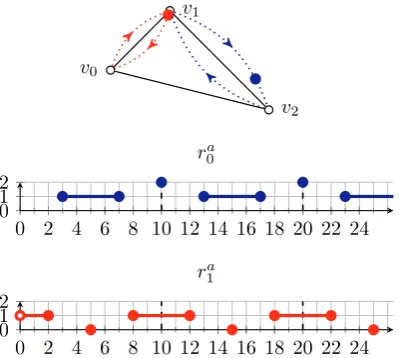
![Figure 4: Sc = {rc0, rc1} is not a solution to I in Example 1 asv0 and v2 miss their relative deadlines.Figure 5: rd1 is not a route of I in Example 1 as rd1(4) = v0,rd1(8) = v2 but FT[v0, v2] = 6.](https://thumb-us.123doks.com/thumbv2/123dok_us/671101.569664/6.595.82.521.110.227/figure-solution-example-relative-deadlines-figure-route-example.webp)
